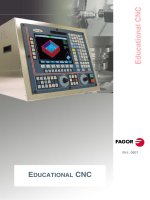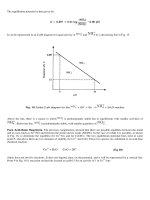Tài liệu Fractography P2 pptx
Bạn đang xem bản rút gọn của tài liệu. Xem và tải ngay bản đầy đủ của tài liệu tại đây (758.03 KB, 10 trang )
Cleavage is a low-energy fracture that propagates along well-defined low-index crystallographic planes known as
cleavage planes. Theoretically, a cleavage fracture should have perfectly matching faces and should be completely flat
and featureless. However, engineering alloys are polycrystalline and contain grain and subgrain boundaries, inclusions,
dislocations, and other imperfections that affect a propagating cleavage fracture so that true, featureless cleavage is
seldom observed. These imperfections and changes in crystal lattice orientation, such as possible mismatch of the low-
index planes across grain or subgrain boundaries, produce distinct cleavage fracture surface features, such as cleavage
steps, river patterns, feather markings, chevron (herringbone) patterns, and tongues (Ref 7).
As shown schematically in Fig. 11, cleavage fractures frequently initiate on many parallel cleavage planes. As the fracture
advances, however, the number of active planes decreases by a joining process that forms progressively higher cleavage
steps. This network of cleavage steps is known as a river pattern. Because the branches of the river pattern join in the
direction of crack propagation, these markings can be used to establish the local fracture direction.
Fig. 11 Schematic of cleavage fracture formation showing the effect of subgrain boundaries. (a) Tilt boundary.
(b) Twist boundary
A tilt boundary exists when principal cleavage planes form a small angle with respect to one another as a result of a slight
rotation about a common axis parallel to the intersection (Fig. 11a). In the case of a tilt boundary, the cleavage fracture
path is virtually uninterrupted, and the cleavage planes and steps propagates across the boundary. However, when the
principal cleavage planes are rotated about an axis perpendicular to the boundary, a twist boundary results (Fig. 11b).
Because of the significant misalignment of cleavage planes at the boundary, the propagating fracture reinitiates at the
boundary as a series of parallel cleavage fracture connected by small (low) cleavage steps. As the fracture propagates
away from the boundary, the numerous cleavage planes join, resulting in fewer individual cleavage planes and higher
steps. Thus, when viewing a cleavage fracture that propagates across a twist boundary, the cleavage steps do not cross but
initiate new steps at the boundary (Fig. 11b) Most boundaries, rather than being simple tilt or twist, are a combination of
both types and are referred to as tilt-twist boundaries. Cleavage fracture exhibiting twist and tilt boundaries are shown in
Fig. 12(a) and 13, respectively.
Fig. 12 Examples of cleavage fractures. (a) Twist boundary, cleavage steps, and river patterns in an Fe-0.01C-
0.24Mn-0.02Si alloy that was fractured by impact. (b) Tongues (arrows) on the surface of a 30% Cr steel weld
metal that fractured by cleavage
Fig. 13 Cleavage fracture in Armco iron showing a tilt boundary, cleavage steps, and river patterns. TEM p-c
replica
Feather markings are a fan-shaped array of very fine cleavage steps on a large cleavage facet (Fig. 14a). The apex of the
fan points back to the fracture origin. Large cleavage steps are shown in Fig. 14(b).
Fig. 14 Examples of cleavage fractures. (a) Feather pattern on a single grain of a chromium steel weld metal
that failed by cleavage. (b) Cleavage steps in a Cu-25 at.% Au alloy that failed by transgranular stress-
corrosion cracking. (B.D. Lichter, Vanderbilt University)
Tongues are occasionally observed on cleavage fracture (Fig. 12b). They are formed when a cleavage fracture deviates
from the cleavage plane and propagates a short distance along a twin orientation (Ref 8).
Wallner lines (Fig. 15) constitute a distinct cleavage pattern that is sometimes observed on fracture surfaces of brittle
nonmetallic materials or on brittle inclusions or intermetallic compounds. This structure consist of two sets of parallel
cleavage steps that often intersect to produce a crisscross pattern. Wallner lines result from the interaction of a
simultaneously propagating crack front and an elastic shock wave in the material (Ref 9).
Fig. 15 Wallner lines (arrow) on the surface of a fractured WC-Co specimen. TEM formvar replica. Etched with
5% HCl. (S.B. Luyckx, University of the Witwatersrand)
Fatigue
A fracture that is the result of repetitive or cyclic loading is known as a fatigue fracture. A fatigue fracture generally
occurs in three stages: it initiates during Stage I, propagates for most of its length during Stage II, and proceeds to
catastrophic fracture during Stage III.
Fatigue crack initiation and growth during Stage I occurs principally by slip-plane cracking due to repetitive reversals of
the active slip systems in the metal (Ref 10, 11, 12, 13, 14). Crack growth is strongly influenced by microstructure and
mean stress (Ref 15), and as much as 90% of the fatigue life may be consumed in initiating a viable fatigue crack (Ref
16). The crack tends to follow crystallographic planes, but changes direction at discontinuities, such as grain boundaries.
At large plastic-strain amplitudes, fatigue cracks may initiate at grain boundaries (Ref 14). A typical State I fatigue
fracture is shown in Fig. 16. State I fatigue fracture surfaces are faceted, often resemble cleavage, and do not exhibit
fatigue striations. Stage I fatigue is normally observed on high-cycle low-stress fractures and is frequently absent in low-
cycle high-stress fatigue.
Fig. 16 Stage I fatigue appearance. (a) Cleavagelike, crystallographically oriented State I fatigue fracture in a
cast Ni-14Cr-4.5Mo-1Ti-6Al-1.5Fe-2.0(Nb + Ta) alloy. (b) Stair-step fracture surface indicative of Stage I
fatigue fracture in a cast ASTM F75 cobalt-base alloy. SEM. (R. Abrams, Howmedica, Div. Pfizer Hospital
Products Group Inc.)
The largest portion of a fatigue fracture consists of Stage II crack growth, which generally occurs by transgranular
fracture and is more influenced by the magnitude of the alternating stress than by the mean stress or microstructure (Ref
15, 17, 18). Fatigue fractures generated during Stage II fatigue usually exhibit crack-arrest marks known as fatigue
striations (Fig. 17, 18, 19, 20, 21, 22), which are a visual record of the position of the fatigue crack front during crack
propagation through the material.
Fig. 17 Uniformly distributed fatigue striations in an aluminum 2024-T3 alloy. (a) Tear ridge and inclusion
(outlined by rectangle). (b) Higher-magnification view of the region outlined by the rectangle in (a) showing the
continuity of the fracture path through and around the inclusion. Compare with Fig. 18.
Fig. 18 Local variations in striation spacing in a Ni-0.04C-21Cr-0.6Mn-2.5Ti-0.7Al alloy that was tested under
rotating bending conditions. Compare with Fig. 17(b).
Fig. 19 Fatigue striations in a 2024-T3 aluminum alloy joined by tear ridges
Fig. 20 Fatigue striations on adjoining walls on the fracture surface of a commercially pure titanium specimen.
(O.E.M. Pohler, Institut Straumann AG)









